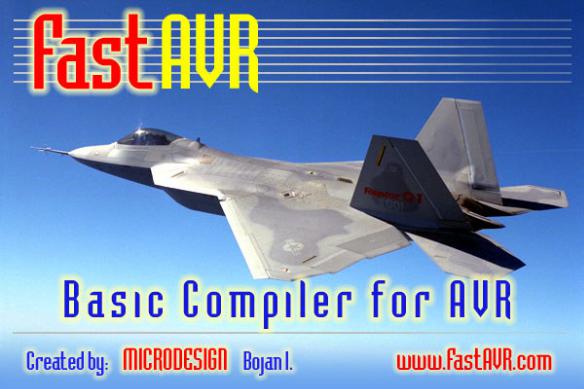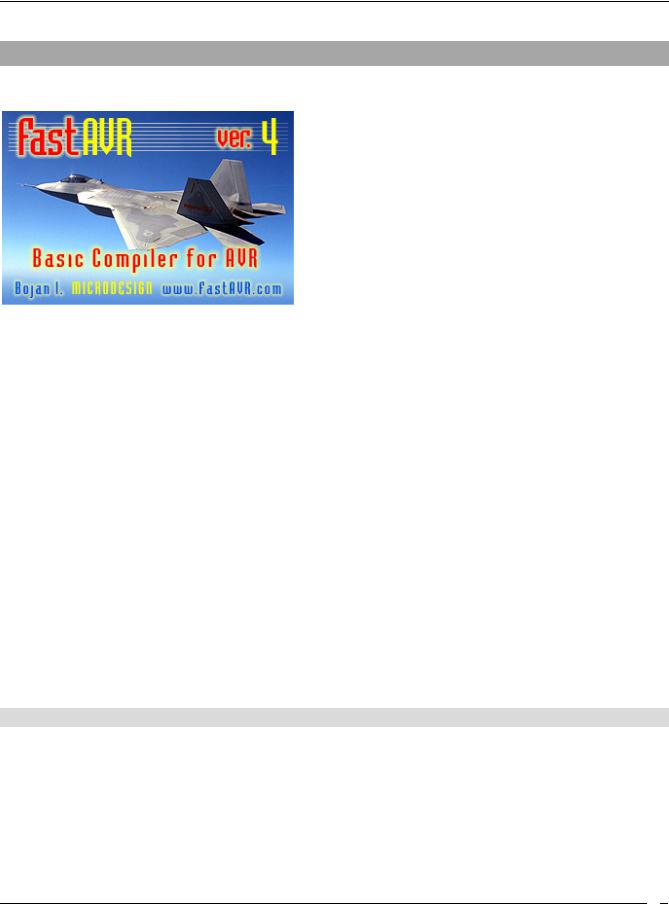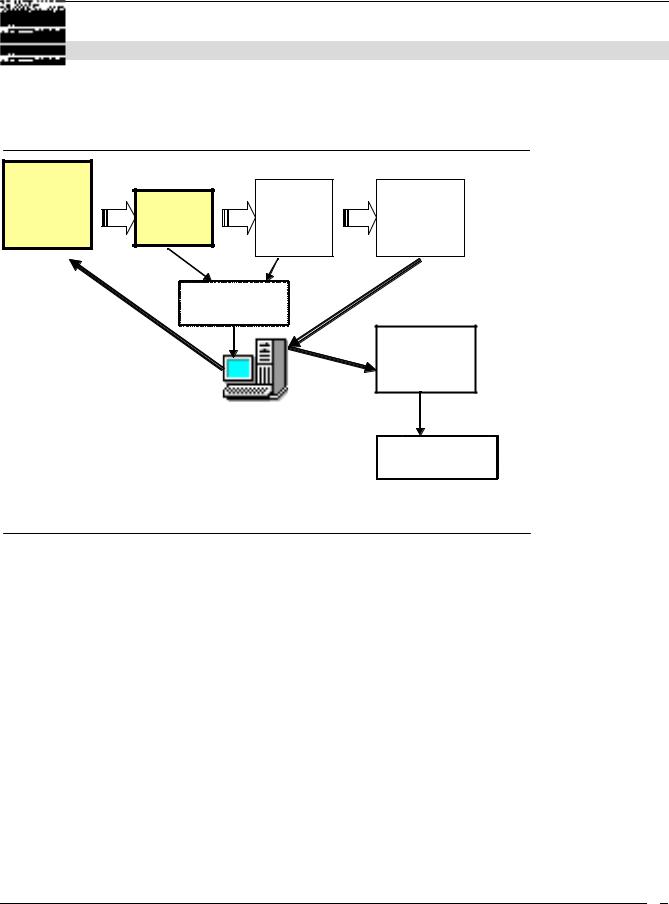
Fast AVR. Basic compiller for AVR. User manual (2004)
.pdf

FastAVR Basic compiler Manual
Basic like Compiler
Version 4.0.0
User Manual
March 2004 by MicroDesign
1

FastAVR Basic compiler Manual
1.Introduction
My sincere thanks to Michael Henning and Steve Childress, for theirs assistance in writing Help and Manual.
Welcome to FastAVR – the best Basic-like language compiler for the Atmel AVR family of 8-bit microprocessors!
Basic is a High Level Language, much easier to learn and understand than assembler or C.
FastAVR Basic is a language consisting of most of the familiar BASIC keywords but has been significantly extended with many additional very useful functions, like LCD, I2C, 1WIRE, Keyboards and many others! FastAVR Basic Compiler has been specially written to fully support the programmer's needs to control the new AVR Microcontroller family!
FastAVR Basic Compiler allows complex operations to be expressed as short but powerful Keywords, without detailed knowledge of the CPU instruction set and internal circuit architecture. However, the processor-s data sheets remains the main source anyway.
FastAVR Basic Compiler hides unnecessary system details from the beginning programmer, but also provides assembler output for advanced programmers!
FastAVR Basic Compiler enables a faster programming and testing cycle.
FastAVR Basic Compiler allows the structure of the program to be expressed more clearly.
1.1.Compiler Operating System Compatibility
Windows 98SE
Windows NT 4
Windows 2000
Windows XP
2

FastAVR Basic compiler Manual
1.2.AVR chip supported
The most current list of AVR chips supported by the compiler is in the readme file that accompanies the installation software. Refer to Atmel's specifications or web site for descriptions. At this User's Guide release, the Atmel AVR chips supported are as follows.
2313
2323
2343
2333
4433
4414
8515
4434
8535
8534
ATiny13
ATiny2313
ATiny26
ATmega161
ATmega163
ATmega103
Atmega8 (see note 1) Atmega16 (see note 1) Atmega32 (see note 1) Atmega323 (see note 1) ATmega64 (see note 1) ATmega128 (see note 1)
 For processors with RAM sizes of 256 bytes or less, such as the 2313, the compiler will create much smaller code sizes – typically 30% or better. This is done by generating code with addresses that are 8 rather than 16 bits – eliminating much needless code.
For processors with RAM sizes of 256 bytes or less, such as the 2313, the compiler will create much smaller code sizes – typically 30% or better. This is done by generating code with addresses that are 8 rather than 16 bits – eliminating much needless code.
Most other Basic and C compilers do not provide this important optimization for small-RAM microprocessors.
Note 1: Compiler support for these processors requires some user-written definitions of some new register names and special coding for certain new features.
3

FastAVR Basic compiler Manual
1.3.Development Environment
The FastAVR Integrated Development Environment (IDE) runs on the Microsoft Windows operating systems. The IDE includes a user friendly, language-context based editor for easliy creating and altering program modules. The IDE, shown below, uses the Atmel AVR Studio software (freeware from Atmel and inexpensive and widely available in-circuit AVR chip programming hardware.
FastAVR Editor |
|
Atmel |
Binary code |
|
for your |
FastAVR |
|||
program’s |
AVR |
for AVR |
||
Compiler |
||||
source code |
Studio |
Chip |
||
|
|
Assembler |
|
|
|
Optional Assembly |
|
||
|
Language Source |
|
||
|
and Listing |
|
|
|
|
|
|
AVR In- |
|
|
|
|
circuit |
|
|
|
|
Programmer |
|
Optional Use of Atmel
AVR Studio Debugger
FastAVR Development Environment
The FastAVR user interface makes the use of the editor, compiler, and Atmel Studio assembler and chip
programmer very easy – there is a single window to control the process. The Atmel Studio's user interface is not needed in most cases, with FastAVR.
The Atmel Studio software is freely available from the Atmel Web site.
There are several in-circuit programmers (ISP) for the AVR chip family. Choose one that is compatible with the ISP software you intend to use. Many of the inexpensive hardware ISP products are compatible with the ISP in the AVR Studio package. A PC parallel port interface to the ISP hardware is commonly used.
4

FastAVR Basic compiler Manual
2.FastAVR Language Reference
2.1.Source code / File Data
FastAVR source code is plain text.
The editor within FastAVR should be used to manage source code and assure the code is properly tab-indented. Source code is displayed by the editor with color highlighting. These denote different keywords and variable types in the program. The editor supports indenting and un-indenting blocks of code.
2.2.Source code - Structure
Source code must be written in the following order:
1.Meta-statements (compiler directives) - where the keywords begin with "$"
2.Declaration of Subroutines (also known as procedures), Functions or Interrupt service routines, using the DECLARE statement
 Note that Subs, Functions and Interrupt service routines must be declared before they are referenced or coded.
Note that Subs, Functions and Interrupt service routines must be declared before they are referenced or coded.
3.Declaration of variables – scalars and arrays, using the DIM statement
4.Constants – their definitions
5.Programm body
2.3.Statements - multiple per line
One line of text in the source code may contain multiple statements. Each statement is separated from the next with a colon ":".
Example:
A = B/2: Print A
A statement may not be continued to a second line.
5

FastAVR Basic compiler Manual
2.4.Comments
All text after a single quote is commentary. A code statement must be completed prior to beginning a comment. A single quote may be the first character in a line, making the entire line a comment.
' this is comment
Multi-line comments are also supported:
'(...
...
...
)'
2.5.Names - Symbols
User-defined constants, variable names, line labels (for GOTO) and I/O aliases (see $DEF) must not begin with a digit and may contain the letters A-Z, a-z, the digits 0-9 and the underscore "_". The compiler is case-insensitive, so "Abc" and "abC" and "ABC" are the same name.
Names must be no longer than 31 characters.
Examples of valid names:
a, A, abc, abc, abc_123
 Avoid use of a leading underscore "_" to reduce the chance of conflicts with compiler-generated run-time symbols . User-defined names must differ from the reserved words in FastAVR. These include the compiler directives, AVR register names, AVR instruction names, etc.
Avoid use of a leading underscore "_" to reduce the chance of conflicts with compiler-generated run-time symbols . User-defined names must differ from the reserved words in FastAVR. These include the compiler directives, AVR register names, AVR instruction names, etc.
To reduce mistakes in the use of types, some programmers use naming conventions such as: Constants are in UPPERCASE
Variables use the first few characters of every name depict the type, such as:
Const strTITLE = "King Of The World"
Const STRLENMAX1 = 20
Dim strSomeName As String * STRLENMAX1
Dim SomeName As Byte ' no prefix implies Byte
Dim bSomeName As Byte ' or be explicit
Dim bitSomeName As Bit
Dim wdSomeName As Word
DimM intSomeName As Integer
Dim lngSomeName As Long
The capital letters help readability.
6

FastAVR Basic compiler Manual
2.6.Types
2.6.1.FastAVR language General
FastAVR is a compiled language. Thus, all variables must be defined prior to their use.
The AVR chips use two independent memory address spaces: One for program code in ROM and one for random access, read/write memory (RAM). EEPROM storage is handled differently than program ROM or RAM. Code cannot be executed from RAM. Constants can be retrieved from program ROM using special instructions or metadirectives when the constant is declared.
 The AVR chip family uses separate memory for code and for data. You must make known to the compiler which data is to go into which memory space. The compiler of course places executable code automatically. Where to store constants is the planning challenge. Programmers not accustomed to this architecture often write code assuming that constants and variables are in the same address space. In some cases, the compiler cannot detect the coding mistake. In AVR chips with EEPROM storage, decisions must be made as to which constants and infrequently changing variables are to be stored in that address space.
The AVR chip family uses separate memory for code and for data. You must make known to the compiler which data is to go into which memory space. The compiler of course places executable code automatically. Where to store constants is the planning challenge. Programmers not accustomed to this architecture often write code assuming that constants and variables are in the same address space. In some cases, the compiler cannot detect the coding mistake. In AVR chips with EEPROM storage, decisions must be made as to which constants and infrequently changing variables are to be stored in that address space.
There are compiler directives (meta-statements) to tell FastAVR how constants should be stored:
∙Store a constant in program memory (typically, flash ROM).
∙Store a constant in program memory but copy them to RAM during program startup. With this method, the programmer accesses constants using the same coding methods as for variables, as in traditional microprocessor architectures. This costs extra storage space and program boot-up initialization code and execution time.
∙Store constants or variables in EEPROM. These are read or written using run-time procedures rather than instructions to directly address EEPROM space as is done for RAM and ROM accesses.
2.6.2.Type Conversions
In some languages, such as Microsoft's Visual Basic, the compiler and run-time libraries do automatic type conversions, e.g., to/from string/arithmetic. This permits the programmer to be generally unconcerned about mixed types in an expression or as arguments to functions and subroutine procedures. In embedded microprocessors, this is not done for reasons of code size and speed optimization. The embedded microprocessor programmer must beware of mixing types in the same expression, and the type of the variable receiving the result of an expression. The compiler will not produce warnings in all cases. For example, adding a FastAVR "word" to an "Integer" with the result going to an integer or word type can produce different results, based on the programmers assumptions about signed or unsigned arithmetic.
Type Conversions – In Assignments
There are no compile-time type conversions built into the compiler for expressions. Any such conversions must be done by coding such in-line or via user functions.
In assignment statements such as the below, if B is a Byte variable and w is a Word:
b = w
Then b receives the low 8 bits of w.
That is, the value to the right of the "=" is converted to the type of the variable to the left of the "=".
7

FastAVR Basic compiler Manual
If w is an Integer with a value of, say, -2, then b will become &hFE or 254.
In this assignment:
w = b
the low 8 bits of w receive b, and the high 8 bits of w will be zero.
In type conversions such as these, with signed numbers (integer and long), the programmer is responsible for accommodating the possibility that the sign is ignored and a multi-byte 2's complement number can become fragmented.
Type Conversions – Implicit
In statement with an expression who's results are not assigned to a specified type, such as:
Print b+w
The run-time code will make the result be the type of the left-most name. This name may refer to a variable or a constant.
Type Conversions – Bit to Byte or Word or Integer
The 0 or 1 value of the bit variable is placed in the least significant bit.
Type Conversions – Byte or Word or Integer to Bit
A Bit variable to the left of an "=" receives the least significant bit of the value to the right of the "=".
 To change a Bit variable based on the result of an expression such as X > 0, use an IF statement.
To change a Bit variable based on the result of an expression such as X > 0, use an IF statement.
2.6.3.Types Arithmetic
FastAVR supports arithmetic (pronunciation: "arith-metic") types of variables as shown in the table, below. Unsupported types are shown for clarity.
For signed numbers, two's complement arithmetic is used by the AVR chips and by the compiler. Thus, –1 in any signed type is all 1's and –2 has the least significant bit = 0.
Type |
Size (Bytes) |
Range |
|
Bit |
1 |
bit |
0 or 1 |
Byte (unsigned char) |
1 |
|
0-255 |
Integer (signed) |
2 |
|
-32767 to +32767 |
Word (unsigned) |
2 |
|
0 to 65535 |
Long (signed) |
4 |
|
-2147483648 to +2147483647 |
Float |
4 |
|
-2.350987E-38 to +8.507062E+37 |
The 32 bit signed integer type is a Long in this compiler.
Use of Longs or Float should be minimized because of the large code sizes required.
8

FastAVR Basic compiler Manual
2.6.4.Assigning Statements
Arithmetic variables
An arithmetic variable may receive a value from
∙A constant
∙A variable
∙The result of a Function call returning an arithmetic type
∙An arithmetic expression which may include a function
The assignment statement is of this form:
<variable> = <expression or constant or function>
Examples:
Gamma = 123
Gamma = X+123
Gamma = FunctionName()
String Variables
A string variable may receive a value from
∙A string constant
∙A string constant stored in an array (in FLASH)
The assignment statement is of this form:
<variable> = <expression or constant or function>
Examples:
String1 = String2
I/O Register Variables, Set and Reset
A special form of assignment statement exists for AVR register bits:
Set <I/O bit name>
Reset <I/O bit name>
Where <I/O bit name> refers to an AVR register and bit.
Examples:
Set PORTB.0 'place a 1 in port B bit 0 (least significant bit) Reset PORTB.7 'place a 0 in port B bit 7 (most significant bit)
I/O Register Variables in General Assignment Statements
A special form of assignment statement exists for AVR register bits: <varname> = <I/O bit name>
Example: |
|
|
|
|
|
|
b = |
PORTB.1 |
'variable b is set to |
1 |
or |
0 |
depending on latched port B bit 1 |
b = |
PINB.1 |
'variable b is set to |
1 |
or |
0 |
depending on momentary state of port |
B bit 1
The I/O register variables may also be used in IF statements, but only where the comparison operator is the "=" operator; i.e., IF PORTB.0 > 0 is not permitted.
9
